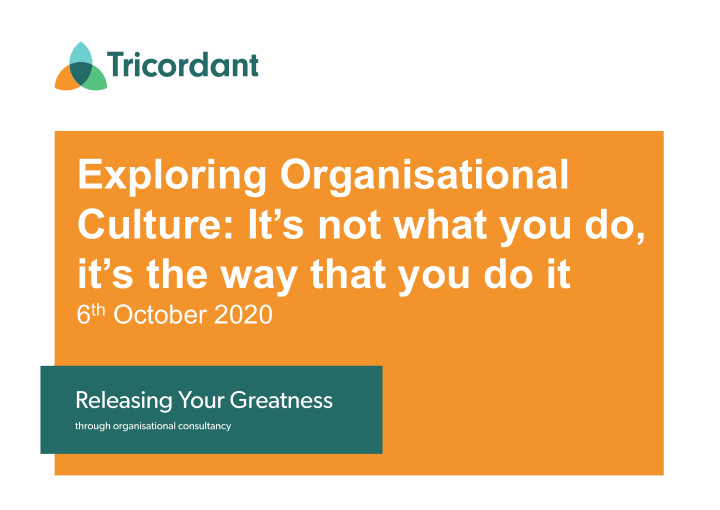



Exploring Organisational Culture: It’s not what you do, it’s the way that you do it 6 th October 2020
Culture – a framing Alastair Mitchell-Baker Tricordant 2
5 What is culture? What happens when no one is looking The environment in which people The way that work and the influence it has on how we do things they think, act, and experience work around here �A pa��e�n of �ha�ed ba�ic a���mp�ion� �ha� �a� learned by a group as it solved its problems of external adaptation and internal integration, that has worked well enough to be considered valid and, therefore to be taught to new members as the correct way to pe�cei�e� �hink and feel in �ela�ion �o �ho�e p�oblem��� Ed Schein
Going Deeper what we see what we say what we believe
Exploring culture: the beginning of change Do they What? really want to know? Which voices are we not Who? hearing? Is it safe to say what I really think? How? Is anything going to change?
Understanding and developing our organisational culture Nigel Terrington 6 September 2020 Understanding and developing our organisational culture | 9
What I will cover • The NAO’s strategic review • Why we considered organisational culture • How we approached our work on culture • The outcomes and alignment with our strategy and OD • Top tips / issues to frame discussion Understanding and developing our organisational culture | 10
The NAO’s strategic review (1) Why we carried out a wide-ranging review • Big changes in our external operating context • Hadn’t reviewed our strategy since 2013 • New Comptroller and Auditor General (10-year term) Principles we worked to • Collective ownership and accountability – Take collective responsibility and ownership as an Executive Team and Board to make the strategy process a success, and hold each other to account for doing so • Participatory and inclusive – Run a participatory and inclusive process that takes suggestions from internal and external stakeholders seriously, and ensures they feel fully included in the strategy process • Diversity and openness – Encourage diversity of voices in the strategy process and give each other and colleagues space to debate and disagree • Transparency – Communicate transparently throughout about progress, as well as decisions that have been made • Sufficiently resourced – Provide the right support and resources to make the strategy process a success • Implementable and simple – Test throughout if we can live with consequences of strategic decisions, and if aspirations and changes are realistic and simple, including for our resource bids, our culture, or speed of required change Understanding and developing our organisational culture | 11
The NAO’s strategic review (2) What we did Understanding and developing our organisational culture | 12
Why we considered organisational culture • Learning lessons of how we approached organisational change previously • Understood we have some quite dominant cultural tendencies, but also sub- cultures in parts of the organisation – and we needed a consensus on what these were; how they help; how they obstruct • Driven by our principle of being participatory and inclusive – we wanted to understand how it really felt for people to work at the NAO • Knew we needed advice: we worked proportionately with Tricordant to equip ourselves to do this Understanding and developing our organisational culture | 13
How we approached our work on culture • Combination of plan and iteration • Started with an Executive Team session • Broadened out over a period of weeks to fuller participation • Workshops for all staff who wanted to contribute • Led by more junior staff so people felt they could speak openly • Communications feedback loop: iterated our thinking on the strategy and OD plan • Applied the same framework and structure for our culture sessions: • Introductory • Diagnostic • Schein / iceberg model to get to core assumptions Understanding and developing our organisational culture | 14
The outcomes and alignment with our strategy Our work on culture had the following benefits in terms of developing our strategy: • Emphasis to all our staff that strategy will not succeed without commitment to adapting how we work and behave • Provided a shared consensus on the diagnosis • Enabled us to provide a statement of our future intended direction • New expression of values used as reference point in home-working Understanding and developing our organisational culture | 15
Top tips / issues to frame discussion • Tone from the top: genuine senior leadership support is critical • Alignment and full integration of organisational culture work with strategy development • Lead the work internally (and in non-hierarchical way) to enhance ownership – proportionate use of consultants • Consult and engage as far and wide as possible • Use the strengths in your organisational culture – e.g. intellectual curiosity and challenge • Be prepared to hear difficult and uncomfortable feedback – and don’t be defensive about that Understanding and developing our organisational culture | 16
Thank you Follow the Follow the NAO View our blog NAO on on LinkedIn www.nao.org.uk Twitter www.linkedin.com/ /naoblog @NAOorguk company/naoorgu k All reports are Subscribe to Contact: If you are interested in available at notifications Nigel Terrington the NAO’s work and www.nao.org.u with 020 7798 5479 support for Parliament k NAO nigel.terrington@nao.org.u please contact: preference k parliament@nao.org.uk centre Understanding and developing our organisational culture | 17
Thank you for your time Book a slot with one of our team to explore your own challenges and get specific help and advice https://www.tricordant.com/ free-45-minute- consultation / 18
Recommend
More recommend